Mary Anne Yarde's Blog: The Coffee Pot Book Club , page 181
March 30, 2018
#Bookreview ~ Uther's Destiny (A Light in the Dark Ages Book 3) #Arthurian #HistoricalFiction @timwalker1666
Uther's Destiny:A Light in the Dark Ages Book 3By Tim Walker
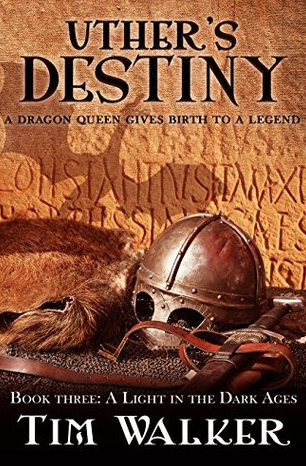
Fifth century Britannia is in shock at the murder of charismatic High King, Ambrosius Aurelianus, and looks to his brother and successor, Uther, to continue his work in leading the resistance to barbarian invaders. Uther’s destiny as a warrior king seems set until his world is turned on its head when his burning desire to possess the beautiful Ygerne leads to conflict. Could the fate of his kingdom hang in the balance as a consequence?
Court healer and schemer, Merlyn, sees an opportunity in Uther’s lustful obsession to fulfil the prophetic visions that guide him. He is encouraged on his mission by druids who align their desire for a return to ancient ways with his urge to protect the one destined to save the Britons from invaders and lead them to a time of peace and prosperity. Merlyn must use his wisdom and guile to thwart the machinations of an enemy intent on foiling his plans.
Meanwhile, Saxon chiefs Octa and Ælla have their own plans for seizing the island of Britannia and forging a new colony of Germanic tribes. Can Uther rise above his family problems and raise an army to oppose them?
Book three in A Light in the Dark Ages series, Uther’s Destiny is an historical fiction novel set in the Fifth Century - a time of myths and legends that builds to the greatest legend of all – King Arthur and his knights.
This book is preceded in the series by Abandoned (book one) and Ambrosius: Last of the Romans (book two).
The Coffee Pot Book Club Review

"Death with honour means more to me than living on in disgrace!"The History of the Kings of Britain by Geoffrey of Monmouth
.
The Saxons keep on coming like an evil plague. They bring nothing but blood, fire, and death. Something must be done to stop them.
Uther Pendragon, the newly crowned King of the Britons, is determined to end the Saxons' ambitions and send them back to where they came from. His every desire is to see the Kingdom at peace. But then he meets Ygerne and everything changes. War takes second place to lust. Uther will have what he desires regardless of the cost to himself, his nobles, and to his nation.
Merlyn is reminded of a prophecy about a boy who will become King. Sensing an opportunity he gives Uther what he wants and the Kingdom of Britannia what it needs. But Merlyn has many enemies and they will stop at nothing to make sure the prophecy never comes true.
I have read Gefforey of Monmouth's History of the Kings of Britain many times. Uther's Destiny (A Light in the Dark Ages Book 3) by Tim Walker is a refreshing retelling of the story of Uther and the boy who would be King.
Uther Pendragon is one of those characters who you are not to sure you should like that much. He is a self-centred King, who always gets what he wants. I thought Mr Walker portrayed him beautifully. Uther is a very flawed character but that makes him all the more believable. Merlyn, who is also pivotal to this story, manipulates events in order for the prophesy to come true. He, like Uther, is not the most likeable of characters. But then, he wasn't in the stories of old either.
I thought the depiction of the Saxons was wonderful. It was great to have the perspective of both sides of the story. This really gave the story depth and kept the pace fast and engaging.
I thoroughly enjoyed Uther's Destiny (A Light in the Dark Ages Book 3), and if you enjoy Arthurian fiction then this should definitely be on your 'to read' list!
Amazon US Amazon UK
Tim Walker
 Tim Walker is an independent author based in Windsor, UK. Tim’s background is in marketing, journalism, editing and publications management. He began writing an historical series, A Light in the Dark Ages (set in the Fifth Century), in 2015, starting with a novella set at the time the Romans left Britain – Abandoned. This was followed in 2017 with a novel – Ambrosius: Last of the Romans, and the third installment, Uther’s Destiny, has just been released in March 2018.
Tim Walker is an independent author based in Windsor, UK. Tim’s background is in marketing, journalism, editing and publications management. He began writing an historical series, A Light in the Dark Ages (set in the Fifth Century), in 2015, starting with a novella set at the time the Romans left Britain – Abandoned. This was followed in 2017 with a novel – Ambrosius: Last of the Romans, and the third installment, Uther’s Destiny, has just been released in March 2018.His creative writing journey began in July 2015 with the publication of a book of short stories, Thames Valley Tales. In 2016 his first novel, a futuristic/dystopian thriller, Devil Gate Dawn was exposed on the Amazon Scout programme prior to publication. Both titles were re-launched with revised content, new covers and in print-on-demand paperback format in December 2016.
In January 2017 his first children’s book, The Adventures of Charly Holmes, co-written with his 12-year-old daughter, Cathy, was published. In September 2017 he published a second collection of short stories –Postcards from London.
Tim loves to hear from readers, you can find him: Website Newsletter sign-up Amazon Author Page Facebook Twitter
Published on March 30, 2018 23:00
#BookReview ~ The German Half-Bloods (The Half-Bloods Series Book 1) by Jana Petkien #HistoricalFiction #WW2 @AuthoJana
The German Half-Bloods (The Half-Bloods Series Book 1)
by Jana Petken
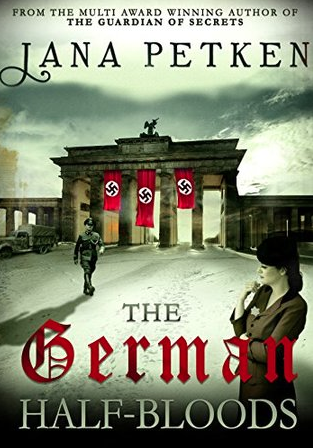
From the Multi-Award-Winning Author comes, The German Half-Bloods.
“A historical novel steeped in horror, danger and suspense; a true page-turner.”
Germany, September 1939. At the outbreak of War, Dieter Vogel and his family face catastrophic events and separation as each member embarks on their deadly paths towards survival, love, and freedom.
Dieter Vogel, a German industrialist, believes in protecting his family at all costs, but in a bid to keep his English wife and children safe, he is plunged into a well of deceit that tears the family apart.
Doctor Paul Vogel is coerced into working in the Nazi eugenics programme and soon discovers that sterilising handicapped and mentally-ill Germans is just a prelude to a more lethal plan against those the Reich deem unworthy of life. Paul, trapped by the SS, seeks help from the unlikeliest of people and is plunged into a world of espionage and murder.
British Army Major, Max Vogel, is attached to The British Intelligence Services and Winston Churchill’s Special Operations Executive. His missions in occupied Europe are fraught with danger, and his adulterous affair with a woman he cannot give up leads him deeper into the quagmire of treachery and lies.
Wilmot Vogel dreams of winning the Iron Cross, but when he confronts a mass killing of Jews in Poland, his idolatry of Hitler is shaken to its roots, and he finds himself imprisoned in the infamous Dachau concentration camp with no release date in sight.
Hannah Vogel has no ambition other than to marry her English fiancé, Frank, before the lines of war are drawn. Against her father’s wishes, she leaves Berlin on the eve of the German invasion of Poland, but when she arrives in England, she learns that Frank is not the civilian engineer he claims to be.
The Coffee Pot Book Club Review

In Nazi Germany nothing and no one is what they seem…
Dieter Vogel is a businessman first and foremost. He has a factory, and the Nazis need somewhere to produce their gas. He also has an English wife, and he will do whatever it takes to keep her safe. And as for his children, well, they will have to toe-the-line and do as they are told. Germany is counting on them. And so is he.
A story so haunting that it left me in tears on more than one occasion, The German Half-Bloods (The Half-Bloods Series Book 1) by Jana Petken is one of those books where the topic is sometimes hard to read about, but it is impossible to forget. This is a story that is going to stay with you long after you have turned the last page.
The book is set in the early days of World War II. The story follows Dieter Vogel and his grown-up sons and son-in-law as they are forced to witness, and in some cases participate, in the early days of the Holocaust.
Paul Vogel, a young doctor who had hoped to change the world with his radical ideas on how to treat the mentally ill, finds himself in an experimental Nazi hospital, where to his disgust his patients are not just being experimented on. They are being murdered. Paul is such a gentle soul. His actions when he discovers the truth, came as no surprise. Paul was a character that I simply adored. His integrity and his kindness never wavered in the face of such systematic brutality. A true hero.
Paul's twin brother, Max, is a British Agent and when Paris falls he finds himself in the thick of the action. Like Paul, Max is steadfast in his beliefs, and he is willing to risk everything to stop the war and to bring down Hitler's Third Reich.
Wilmot Vogel is a character that really grew during this story. He started out as an ardent Nazi supporter and had romantic notions of being awarded an Iron Cross. But his eyes are brutally opened to the truth behind the fancy uniforms and the grand rallies. Like his brother, Paul, he will not participate in the murder of innocent citizens. I am not going to give away any spoiler, but there is a scene in Russia where Wilmot really showed what he was made of.
I am a big fan of Jana Petken's books. I thought The Flock Trilogy was wonderfully executed, but The German Half-Bloods was astounding. This story is staggeringly compelling, and I simply could not put it down.
I tutor this era of history and I have done so for many years. Ms Petken has obviously done her research. She depicted wartime Berlin and the events leading up to it very accurately. Kudos, Ms Petken. Book 2 cannot come soon enough!
Amazon US Amazon UK
Jana Petken
 Jana Petken is a bestselling historical fiction novelist and screenwriter.
Jana Petken is a bestselling historical fiction novelist and screenwriter. She is critically acclaimed as a bestselling, gritty, author who produces bold, colourful characters and riveting storylines. She is the recipient of numerous major international awards for her works of historical fiction and is presently in talks with film producers regarding one of her titles.
Before life as an author, she served in the British Royal Navy. During her service, she studied Naval Law and history. After the Navy, she worked for British Airways and turned to writing after an accident on board an aircraft forced her to retire prematurely.
Jana loves to hear from readers, you can find her: Website Twitter
Published on March 30, 2018 23:00
March 29, 2018
Life in the time of the Marie Antoinette by Lorrie Anne #Versailles #France #History @AuthorLorrieAnn
Life in the time of the Marie Antoinette:By Lorrie Anne
Bonjour! Welcome to the Palace of Versailles, the country residence of the notorious Queen Marie Antoinette and King Louis XVI.



As you promenade the full length of the 239.5 feet Hall of Mirrors to pay your respects at the foot of the throne of King Louis XVI, you are awed by the 17 magnificent archways accented with 357 mirrors and 30 artistic ceiling paintings that take your breath away. You are among the privileged rulers of Persia (1715) and the Ottoman Empire (1742), who have promenaded the length of the gallery while members of the French court look down upon you as they sit in amphitheater style seating on either side in a show of superior wealth and power. As a portrait below attests, Marie, the Archduchess of Austria, was a beautiful child and indulged by her royal Hapsburg parents. By the age of twenty-two, after having become Queen of France, Marie often sat for repeated portrait paintings, complaining that no artist was able to capture her true image.
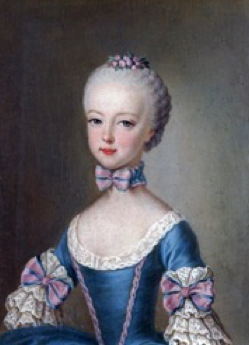
As Queen of France, the extravagant Marie Antoinette would change clothing several times a day. Her wardrobe included twelve ceremonial outfits, twelve frocks, and twelve elaborate full dresses. Wearing white linen was considered a display of cleanliness, whereas commoners wore hemp. Shirts, bed linens and table linens were extremely expensive and seen as a possession of the rich. In the portrait painted by Vigée-Lebrun, Marie is wearing a white silk court gown with panniers— quite daring given the gauze and airy lightness of the dress in comparison to styles of the time.
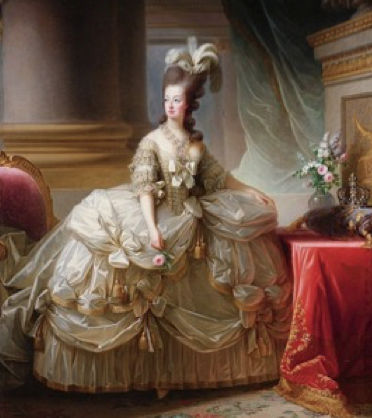 Vigée-Lebrun painting of Marie Antoinette
Vigée-Lebrun painting of Marie Antoinette  Left: Marie Antoinette en chemise, 1783 portrait by Louise Élisabeth Vigée Le Right: Marie-Antoinette, painting by Élisabeth Vigée-Lebrun
Left: Marie Antoinette en chemise, 1783 portrait by Louise Élisabeth Vigée Le Right: Marie-Antoinette, painting by Élisabeth Vigée-Lebrun Versailles with its strict court etiquette was stifling to Marie Antoinette, so she escaped to the Petite Trianon, where the scented orange blossom trees and flower gardens provided freedom. In contrast to the formal palace gardens, the Trianon offered meandering paths, hills and streams, a working farm with live animals and a neo-Classical Temple of Love. Known for her extravagant indulgences, Marie Antoinette had her own theater installed in the Trianon, where she and her devoted friends acted out plays while the King attended to his duties at the Palace.
King Louis XVI was awakened every morning at 8:30 a.m. and given a dry bath in public, a wiping down with a white cloth, beginning his daily schedule according to strict court etiquette. Only the highest members of the court (nobles, cardinals, archbishops, ambassadors, dukes, peers, etc.) were permitted to watch the king dress, a ceremony known as the grand lever. The privileged stood encircled around the royal bed as the highest-ranking prince gave the King his clothing.

After dining, guests would stroll in the gardens for fresh air.

 The Orangerie By Urban at French
The Orangerie By Urban at French Bathing ranged from every eight days to once a year, where royalty often partook of the spa. Cleanliness meant “having good breath and feet that didn't smell" Toute L'Histoire(2017). Stories abound of a dirty Versailles with “members of the court relieving themselves in the corner of stairwells, of a King holding audiences on his throne, a chair with a hole in the seat..." (Toute L'Histoire, 2017). Sign up for Lorrie’s future blog posts to see the King’s two private toilets.
Perfumes were used to mask the smells and were seen as cleansing the person from within. The court of Louis XIV became known as "the perfumed court." King Louis XIV preferred the smell of oranges and had his fountains scented with orange blossom and jasmine water (Toute L’Histoire, 2017).

The King’s valets sprayed the palace with the scent of orange blossoms, which were believed to be an aphrodisiac. Scents were applied daily to the skin, clothing, fans, and furniture. King Louis XIV’s mistress, Madame de Montespan, had her naked body rubbed with perfumes, which the King later believed was the cause of his migraines when she fell out of favor.
Perfumes were used to cast spells, hide smells, and as a disinfectant to dispel the plague. Perfume burners were placed in hospitals to purify the air. Perfume transformed the wearer and cleansed their health.
The ladies of court sought Jean-Louis Fargeon, Marie Antoinette’s perfumer, to concoct cosmetics, rouges, soaps and creams to whiten their hands and face, powders and opiate elixirs for their teeth, and tablets and rinses to perfume the mouth (Feydeau, 2004, p. 34). Oils, colored powders, and dyes were used to color the hair, while perfumed gloves were believed to be beneficial to the skin. Marie Antoinette had more than 18 pairs of perfumed kidskin gloves made each month.
Perfumes were decanted in small porcelain bottles decorated with gold or silver art motifs. Marie Antoinette preferred perfumes and toilet waters, such as the eau de fleur d’orange, also known as eau do Roi or the King’s water. She took great care of her skin with pomades scented with roses, vanilla, and other flowers. Marie’s perfumer also made rouge pomade to enhance her lips. Perfume soon became a sign of wealth, where a different scent was worn every day, even during the French Revolution, when "Parfum a la Guillotine" was created!
Lorrie Anne
 Lorrie Anne is a historical author who loves palaces, balls with beautiful French gowns, eating tea and crumpets, and basically anything a royal princess would do.
Lorrie Anne is a historical author who loves palaces, balls with beautiful French gowns, eating tea and crumpets, and basically anything a royal princess would do. She is fascinated with Marie Antoinette, Queen Victoria, and the Empress Sissi of Austria. She loves traveling around Europe and writing about the many places she visits to share the fascinating stories of history with you.
More information about Lorrie Anne can be found on her website at LorrieAnne.com, Facebook, and Twitter. She is always glad to hear from readers and history enthusiasts.
References:
Versailles picture 1 : By Kimberly Vardeman (Flickr: Versailles) [CC BY 2.0 (http://creativecommons.org/licenses/by/2.0)], via Wikimedia Commons
Versailles picture 2 : By Wikiwee (Digital camera shot on vacation.) [Public domain], via Wikimedia Commons
Versailles picture 3 : Myrabella / Wikimedia Commons, via Wikimedia Commons
Picture 4 : Jean-Étienne Liotard [Public domain], via Wikimedia Commons
Picture 5 : Vigée-Lebrun painting of Marie Antoinette. Photo: Wikipedia/public domain
Picture 6 & 7 : Left: Marie Antoinette en chemise, 1783 portrait by Louise Élisabeth Vigée Le Brun. Photo: Wikipedia/Public DomainRight: Marie-Antoinette, painting by Élisabeth Vigée-Lebrun, 18th century; in the Versailles Museum.© Ronald Sheridan/Ancient Art & Architecture Collection
Picture 15 : By Copyleft (Own work) [CC BY-SA 3.0 (https://creativecommons.org/licenses/by-sa/3.0)], via Wikimedia Commons
Picture 16 : The Orangerie By Urban at French Wikipedia [GFDL (http://www.gnu.org/copyleft/fdl.html) or CC-BY-SA-3.0 (http://creativecommons.org/licenses/by-sa/3.0/)], via Wikimedia Commons
All other images are credited to Lorrie Anne
Published on March 29, 2018 23:00
March 28, 2018
Levirate Marriage, or How to Complicate the Lives of Your Characters By Stephanie Churchill #amwriting #History @WriterChurchill
Stephanie loves to hear from readers, you can find her: Website Facebook
The Scribe's Daughter
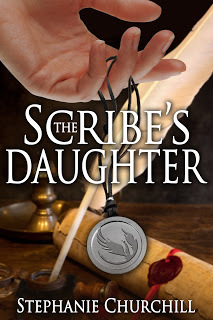 In this gripping sequel to The Scribe's Daughter, a young woman finds herself unwittingly caught up in a maelstrom of power, intrigue, and shifting perceptions, where the line between ally and enemy is subtle, and the fragile facade of reality is easily broken.
In this gripping sequel to The Scribe's Daughter, a young woman finds herself unwittingly caught up in a maelstrom of power, intrigue, and shifting perceptions, where the line between ally and enemy is subtle, and the fragile facade of reality is easily broken.Irisa's parents are dead and her younger sister Kassia is away on a journey when the sisters’ mysterious customer returns, urging Irisa to leave with him before disaster strikes. Can she trust him to keep her safe? How much does he know about the fate of her father? Only a voyage across the Eastmor Ocean to the land of her ancestors will reveal the truth about her family’s disturbing past. Once there, Irisa steps into a future she has unknowingly been prepared for since childhood, but what she discovers is far more sinister than she could have ever imagined. Will she have the courage to claim her inheritance for her own?
Amazon
Published on March 28, 2018 23:00
March 27, 2018
Author’s Inspiration ~ Richard Buxton #HistFic #CivilWar #mustread @RichardBuxton65
Please give a warm welcome to historical fiction author, Richard Buxton. Richard is going to share with us his inspiration behind his fabulous book…
Whirligig

Shire leaves his home and his life in Victorian England for the sake of a childhood promise, a promise that pulls him into the bleeding heart of the American Civil War. Lost in the bloody battlefields of the West, he discovers a second home for his loyalty.
Clara believes she has escaped from a predictable future of obligation and privilege, but her new life in the Appalachian Hills of Tennessee is decaying around her. In the mansion of Comrie, long hidden secrets are being slowly exhumed by a war that creeps ever closer.
The first novel from multi-award winning short-story writer Richard Buxton, Whirligig is at once an outsider’s odyssey through the battle for Tennessee, a touching story of impossible love, and a portrait of America at war with itself. Self-interest and conflict, betrayal and passion, all fuse into a fateful climax.
Author’s Inspiration
Thank you, Mary Anne, for inviting me to write about the inspiration behind Whirligig. I know some authors have a ‘kepow!’ moment when the idea for a book strikes them but the inspiration for Whirligig was more gradual and certainly more various; the characters, plot and theme each had their own genesis. The setting was a given. I’d already written a number of short stories related to the American Civil War, so when I chose to embark on a novel I wanted to further explore my fascination for America and that period.
The inspiration for the lead character, Shire, came from my late father, Tom Buxton, which is one of the reasons Whirligig was dedicated to him. After he became a widower he decided to write about his early life in Bedfordshire. As a teenager during WWII – outside of school hours – he worked on a farm at Woburn Abbey, the Duke of Bedford’s Estate. Even as late as the early 1940s they still retained a number of Shire horses to work the land. My father helped to feed and harness them. He wrote about the horses and the people with great nostalgia and wonderful detail.
 Shire Horses ~ Wikipedia
Shire Horses ~ Wikipedia
The working methods with the great horses were largely unchanged from the 1860s. I imagined a character called Shire, a play on the horses and his rural English roots. I instantly loved the idea of an English protagonist in an American war. It would make him an outsider, which always helps, but also it had echoes of my own experience of America. As a very young man I spent eighteen months in Upstate New York as a wide-eyed student. The story of America has held a fascination for me ever since. I wondered what it would be like for Shire to arrive in America a century earlier and in the middle of a great civil war. I wanted to write it through his eyes rather than someone born to America.
 Image by Techfun ~ Pixabay
Image by Techfun ~ Pixabay
I didn’t consciously put my father’s characteristics into Shire, but looking back I can see they have the same unswerving urge to do the right thing, and the same romantic outlook on the world. Whether Shire will still have that outlook when the trilogy ends, we’ll have to see. He has a lot to go through.
So I had my lead character but why would he go to America? The inspiration for the plot is slightly prosaic in that it came from watching an episode of ‘Who do you think you are?’, the show where celebrities look into their family history. The celebrity was Bruce Forsyth and the skeleton in his closet was a Victorian ancestor who left his wife and family in England, then sailed to America to marry again. I thought how easy it must have been back then to behave in this way; who would ever know? Well, Shire would as it turned out. He discovers a secret marriage and the honourable thing to do is to head over to America, find his childhood friend Clara, and give her the bad news. Unfortunately for him, there’s a war in the way.
The plot itself spawned another character. I needed a ship Shire could sail on to America so headed up to the Liverpool maritime museum. I found a ship called the Scotia but also, the in their archives, the wonderful character that is George Alfred Trenholm. Trenholm had a multi-national business in shipping, banking and railroads; all sorts of things. His home was Charleston, South Carolina, but he had an office in Liverpool and during the war it was full of Confederate operators. Pretty much all Confederate business, legitimate and shady, went through that office. He also had ties in with the British parliament, and his great wealth and business interests kept him close to the Confederate government. I had to have him. He gave the novel extra dimensions of power, politics and self-interest and I was able to weave him in with Shire’s story.
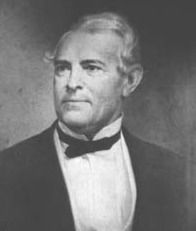 George Alfred Trenholm ~ Wikipedia
George Alfred Trenholm ~ Wikipedia
If I do have a ‘Kepow!’ moment I think it was in the Chicago Institute of Art where I found my theme. I’d flown out alone to begin a two week road-trip down to Atlanta. Having completed draft one of the unnamed novel, I had an itinerary of museums, plantation houses and battle sites to visit where I hoped to harvest lots of believable detail. The two days in Chicago was an indulgence. I wandered into the folk-ark section of the Institute and found my Whirligig, a wooden, five-foot high piece of early Americana composed of cogs and sails painted red, white and blue with a marching soldier on top. Craftsmen used take these devices to county fairs or markets and people would give them penny’s to watch the sails turn. I knew right then that I’d found something that mattered. As I started down through Illinois and the Whirligig stayed in my mind.

I know of no other country as self-obsessed as America. The flag is ubiquitous. It flies before public buildings and schools; private lawns contain flagpoles large and small (usually large). Almost every business uses the American dream by association. I drove past the ‘Great American Car Wash’, ate a ‘Star Spangled Burger’. There’s no escaping it. If anything, it’s more pervasive as you get into the Southern states. I thought of my Whirligig and how pieces like it might have been on that bandwagon a hundred and fifty years ago. I began to see how I could use the object in the book. I invented the eponymous Whirligig Man, dragging his Whirligig from town to town. His brief appearances in the book are some of my favourite passages. I try to convey through him how a broken America was trying to preserve but also re-invent itself at the same time.
That perhaps makes the book sound more worthy that it is. At heart it remains an odyssey and a love story wrapped in troubled times, but it was wonderful to find a theme to run through it.
Aside from character, plot and theme, I could point out a thousand different lines in the novel that had their own moment of inspiration, mostly gained by going to the places where the history happened. I’ve been on battlefields at dusk in Georgia to listen to the insects and watch the flying silhouettes of beetles. I’ve felt the boom of cannon twitch my lightweight coat at two-hundred yards. I’ve been inside slave huts in Tennessee and wondered how anyone could live in such heat. I’ve seen musket smoke, heavier than the air, settle and nest in wet grass. I’ve rubbed the smoothness and felt the warmth of cannon that have spent a long day in the sun.
Sometimes inspiration comes line by line, and sometimes you find a Whirligig.
Links for PurchaseAmazon
About the author Richard Buxton grew up in Wales but has lived in Sussex for the last thirty years. He is a 2015 graduate of the Creative Writing Masters programme at Chichester University. He studied in America during his twenties and tries to return there as often as he can for research and inspiration. His writing successes include winning the Exeter Story Prize, the Bedford International Writing Competition and the Nivalis Short Story award. His US Civil War novel, Whirligig, released this spring, was shortlisted for the 2017 Rubery International Book Award.Connect with Richard…
Richard Buxton grew up in Wales but has lived in Sussex for the last thirty years. He is a 2015 graduate of the Creative Writing Masters programme at Chichester University. He studied in America during his twenties and tries to return there as often as he can for research and inspiration. His writing successes include winning the Exeter Story Prize, the Bedford International Writing Competition and the Nivalis Short Story award. His US Civil War novel, Whirligig, released this spring, was shortlisted for the 2017 Rubery International Book Award.Connect with Richard…
Website Facebook Twitter
Whirligig

Shire leaves his home and his life in Victorian England for the sake of a childhood promise, a promise that pulls him into the bleeding heart of the American Civil War. Lost in the bloody battlefields of the West, he discovers a second home for his loyalty.
Clara believes she has escaped from a predictable future of obligation and privilege, but her new life in the Appalachian Hills of Tennessee is decaying around her. In the mansion of Comrie, long hidden secrets are being slowly exhumed by a war that creeps ever closer.
The first novel from multi-award winning short-story writer Richard Buxton, Whirligig is at once an outsider’s odyssey through the battle for Tennessee, a touching story of impossible love, and a portrait of America at war with itself. Self-interest and conflict, betrayal and passion, all fuse into a fateful climax.
Author’s Inspiration
Thank you, Mary Anne, for inviting me to write about the inspiration behind Whirligig. I know some authors have a ‘kepow!’ moment when the idea for a book strikes them but the inspiration for Whirligig was more gradual and certainly more various; the characters, plot and theme each had their own genesis. The setting was a given. I’d already written a number of short stories related to the American Civil War, so when I chose to embark on a novel I wanted to further explore my fascination for America and that period.
The inspiration for the lead character, Shire, came from my late father, Tom Buxton, which is one of the reasons Whirligig was dedicated to him. After he became a widower he decided to write about his early life in Bedfordshire. As a teenager during WWII – outside of school hours – he worked on a farm at Woburn Abbey, the Duke of Bedford’s Estate. Even as late as the early 1940s they still retained a number of Shire horses to work the land. My father helped to feed and harness them. He wrote about the horses and the people with great nostalgia and wonderful detail.
 Shire Horses ~ Wikipedia
Shire Horses ~ WikipediaThe working methods with the great horses were largely unchanged from the 1860s. I imagined a character called Shire, a play on the horses and his rural English roots. I instantly loved the idea of an English protagonist in an American war. It would make him an outsider, which always helps, but also it had echoes of my own experience of America. As a very young man I spent eighteen months in Upstate New York as a wide-eyed student. The story of America has held a fascination for me ever since. I wondered what it would be like for Shire to arrive in America a century earlier and in the middle of a great civil war. I wanted to write it through his eyes rather than someone born to America.
 Image by Techfun ~ Pixabay
Image by Techfun ~ PixabayI didn’t consciously put my father’s characteristics into Shire, but looking back I can see they have the same unswerving urge to do the right thing, and the same romantic outlook on the world. Whether Shire will still have that outlook when the trilogy ends, we’ll have to see. He has a lot to go through.
So I had my lead character but why would he go to America? The inspiration for the plot is slightly prosaic in that it came from watching an episode of ‘Who do you think you are?’, the show where celebrities look into their family history. The celebrity was Bruce Forsyth and the skeleton in his closet was a Victorian ancestor who left his wife and family in England, then sailed to America to marry again. I thought how easy it must have been back then to behave in this way; who would ever know? Well, Shire would as it turned out. He discovers a secret marriage and the honourable thing to do is to head over to America, find his childhood friend Clara, and give her the bad news. Unfortunately for him, there’s a war in the way.
The plot itself spawned another character. I needed a ship Shire could sail on to America so headed up to the Liverpool maritime museum. I found a ship called the Scotia but also, the in their archives, the wonderful character that is George Alfred Trenholm. Trenholm had a multi-national business in shipping, banking and railroads; all sorts of things. His home was Charleston, South Carolina, but he had an office in Liverpool and during the war it was full of Confederate operators. Pretty much all Confederate business, legitimate and shady, went through that office. He also had ties in with the British parliament, and his great wealth and business interests kept him close to the Confederate government. I had to have him. He gave the novel extra dimensions of power, politics and self-interest and I was able to weave him in with Shire’s story.
 George Alfred Trenholm ~ Wikipedia
George Alfred Trenholm ~ WikipediaIf I do have a ‘Kepow!’ moment I think it was in the Chicago Institute of Art where I found my theme. I’d flown out alone to begin a two week road-trip down to Atlanta. Having completed draft one of the unnamed novel, I had an itinerary of museums, plantation houses and battle sites to visit where I hoped to harvest lots of believable detail. The two days in Chicago was an indulgence. I wandered into the folk-ark section of the Institute and found my Whirligig, a wooden, five-foot high piece of early Americana composed of cogs and sails painted red, white and blue with a marching soldier on top. Craftsmen used take these devices to county fairs or markets and people would give them penny’s to watch the sails turn. I knew right then that I’d found something that mattered. As I started down through Illinois and the Whirligig stayed in my mind.

I know of no other country as self-obsessed as America. The flag is ubiquitous. It flies before public buildings and schools; private lawns contain flagpoles large and small (usually large). Almost every business uses the American dream by association. I drove past the ‘Great American Car Wash’, ate a ‘Star Spangled Burger’. There’s no escaping it. If anything, it’s more pervasive as you get into the Southern states. I thought of my Whirligig and how pieces like it might have been on that bandwagon a hundred and fifty years ago. I began to see how I could use the object in the book. I invented the eponymous Whirligig Man, dragging his Whirligig from town to town. His brief appearances in the book are some of my favourite passages. I try to convey through him how a broken America was trying to preserve but also re-invent itself at the same time.
That perhaps makes the book sound more worthy that it is. At heart it remains an odyssey and a love story wrapped in troubled times, but it was wonderful to find a theme to run through it.
Aside from character, plot and theme, I could point out a thousand different lines in the novel that had their own moment of inspiration, mostly gained by going to the places where the history happened. I’ve been on battlefields at dusk in Georgia to listen to the insects and watch the flying silhouettes of beetles. I’ve felt the boom of cannon twitch my lightweight coat at two-hundred yards. I’ve been inside slave huts in Tennessee and wondered how anyone could live in such heat. I’ve seen musket smoke, heavier than the air, settle and nest in wet grass. I’ve rubbed the smoothness and felt the warmth of cannon that have spent a long day in the sun.
Sometimes inspiration comes line by line, and sometimes you find a Whirligig.
Links for PurchaseAmazon
About the author
 Richard Buxton grew up in Wales but has lived in Sussex for the last thirty years. He is a 2015 graduate of the Creative Writing Masters programme at Chichester University. He studied in America during his twenties and tries to return there as often as he can for research and inspiration. His writing successes include winning the Exeter Story Prize, the Bedford International Writing Competition and the Nivalis Short Story award. His US Civil War novel, Whirligig, released this spring, was shortlisted for the 2017 Rubery International Book Award.Connect with Richard…
Richard Buxton grew up in Wales but has lived in Sussex for the last thirty years. He is a 2015 graduate of the Creative Writing Masters programme at Chichester University. He studied in America during his twenties and tries to return there as often as he can for research and inspiration. His writing successes include winning the Exeter Story Prize, the Bedford International Writing Competition and the Nivalis Short Story award. His US Civil War novel, Whirligig, released this spring, was shortlisted for the 2017 Rubery International Book Award.Connect with Richard… Website Facebook Twitter
Published on March 27, 2018 23:00
March 26, 2018
Stepping Back in Time to Dine at the Ancient Roman Table by Crystal King #History #Roman #Food @crystallyn
Stepping Back in Time to Dine at the Ancient Roman TableBy Crystal King
As a tourist in Rome today, you can regularly catch glimpses of the ancient past, even beyond the confines of the Roman Forum. Buildings incorporate columns that are several thousand years old, ancient statues grace the courtyards of Renaissance-era palazzos and restaurants are tucked into the below-ground remains of amphitheaters where gladiators once fought.
 Hadrian's Temple
Hadrian's TempleIt’s a bit harder to imagine what daily life was like for the million plus Romans that walked the streets of the city. It was the bustling capital of an Empire, home to people from dozens of countries. Many arrived in the city as slaves, others as traders or diplomats, and still others looking to make a different life than they had in the country. It would be nearly 1800 years before there was another city of its size in the Western world.
The first thing to consider was where all of those people lived. Just like in big cities of today, they lived in apartment buildings, but with one big difference--they were all made of wood. These buildings, called insulae, where often five to six stories high and not always well-made. Fires were common in Rome and particularly virulent fires could destroy hundreds of buildings. This also meant that if you lived in one of these insulae, you weren’t able to cook in your own apartment. Instead, Romans relied on street food from corner shops called popinae where boiled meats and fried food were common fare. The average popinawould have a long counter with jars for storing food set into the counters. You could buy wine and snacks such as olives, bread, and honeyed fritters while you indulged in a bit of dice (often illegal but that never stopped anyone) and perhaps let a woman of ill repute lead you off to a nearby brothel.
 Popina
PopinaWealthy Romans would not be caught dead in a popina; it was only for the plebians, not for anyone with a measure of taste. Instead, for the nobility (who fell into two camps of status, equestrianand the elite patricians), dining was a fairly complex affair. Each home would have its own kitchen with a measure of slaves to prepare and serve the food. Often food such as olives, grapes, apples and sheep were sourced from the noble’s own farms.
Both patricians and equestrians participated in a patron/client system. The wealthy would help and protect “clients” who, in turn, repaid that help in various ways such as voting a particular way on Senate bills. One of the perks of being a client for a wealthy patrician is the chance to be invited to dinner, either as a special guest, or sometimes as what they called a “shadow” or “parasite,” or in other words, a tag-along who sat at the foot of the couches in a lesser spot but expected to flatter their patron and provide witty conversation in payment for their food. It’s where we get the connotation that the word parasite holds today.
Dining at a patrician’s house started in the atrium, where the lararium was. The lararium was a shrine to the household gods and it was customary for guests to stop and offer prayers. Then, they would be whisked away to the triclinium, or dining room. These dining rooms were usually elaborately decorated and some had open ceilings or doors that opened out toward a garden. Before you stepped across the threshold into the triclinium, slaves would wash your feet and hands.
In the triclinium was a three sided couch. Where you ended up on the couch was important, as each space signified your position of respect in relation to your host, who sat in the middle. The couches held nine people, in deference to the nine muses. Diners lay on their left side, propped on their left elbow, keeping the right had free for eating. In the center of the couch was a table, upon which food would be placed.
Diners came equipped with their own napkins and often with their own sachets of spice, used to spice wine in the fashion that they desired. The host would provide spoons with long pointed handles, used to spear food or open shellfish.
Drinking took place after a meal, not usually with the food, and the ancient Romans were very serious about their wine. Often vintages were over a hundred years old. Wine was always watered down and usually clarified with lead or charcoal. Falernian wine was considered to be the finest of wines. The grape that made Falernian wine is thought to be Falenghina, which makes a white wine which can still be found today.
 Triclinium
TricliniumOne custom that most of us today would find unusual, and perhaps unsavory, was the practice of throwing leftover food, bones and crusts onto the floor for the ghosts of the household. These ghosts were thought to be from family members whose bodies might have been buried under the floor of the triclinium. To be a slave that had to clean up after a meal, thereby removing the food from the ghosts, was considered incredibly unlucky.
The food itself came in three courses, but always began with some form of egg dish, and always ended with fruit. Food in ancient Rome was not what we would think of as Italian food today. For one, there were no tomatoes or lemons. Garlic was used medicinally but not to flavor food.
What the ancients did use was a fish sauce called garum, still made in Italy (but called colatura) and which is very similar to Thai and Vietnamese fish sauces still used today. Garum was used to flavor everything, even desserts. But since salt was only used to preserve foods, not to salt them, in small quantities, garum was able to provide the salt flavor and add a bit of umami taste to dishes.
The rare herb, silphium(also called laser), was also popular. Unfortunately, it went extinct in the first century and Emperor Nero is rumored to have had the last sprig. Asafoetida powder or resin, common to Middle Eastern cooking, is believed to be the closest approximation to the taste.
One of the ancient world’s most famous gourmands was Marcus Gavius Apicius, a man who was rumored to be one of the wealthiest in Rome and who loved to entertain. It is thought that Apicius was responsible for several different books about cooking, including one on sauces referenced by several ancient chroniclers, but none has been found. However, a cookbook that bears his name has survived and, ultimately, it is Apicius’s most important legacy. The oldest known collection of recipes, it is believed to have been compiled in the third or fourth century, long after Marcus Gavius Apicius lived, though it is likely that some of the recipes were first developed in his kitchen. While Apicius is full of ancient delicacies such as roasted peacock, flamingo tongues, boiled sow vulva, testicles, and other foods we would not commonly eat today, there are many others that are still popular, including tapenade, absinthe, fried dough, and meatballs. There is even a recipe for Roman milk and egg bread that is identical to what we call French toast. And, contrary to popular belief, foie gras was not originally a French delicacy. The dish dates back twenty-five hundred years, and the ancient chronicler Pliny credits Apicius with developing a version using pigs instead of geese by feeding hogs dried figs and giving them an overdose of mulsum (honey wine) before slaughtering them.
Which just goes to prove that hipsters didn’t really invent “foodie” culture. It has existed for centuries, in many forms, but it was the ancient Romans who first made the art of dining truly magnificent.
Crystal King
 Crystal King is the author of FEAST OF SORROW, about the ancient Roman gourmand, Apicius, and the forthcoming THE SECRET CHEF (2019) about Renaissance papal chef, Bartolomeo Scappi. A culinary enthusiast and marketing expert, Crystal’s writing is fueled by a love of history and a passion for the food, language, and culture of Italy. She has taught classes in writing, creativity and social media at several universities including Harvard Extension School and Boston University, as well as at GrubStreet, one of the leading creative writing centers in the US. She lives in Boston.To find out more about Crystal and her books… Website.
Crystal King is the author of FEAST OF SORROW, about the ancient Roman gourmand, Apicius, and the forthcoming THE SECRET CHEF (2019) about Renaissance papal chef, Bartolomeo Scappi. A culinary enthusiast and marketing expert, Crystal’s writing is fueled by a love of history and a passion for the food, language, and culture of Italy. She has taught classes in writing, creativity and social media at several universities including Harvard Extension School and Boston University, as well as at GrubStreet, one of the leading creative writing centers in the US. She lives in Boston.To find out more about Crystal and her books… Website. Feast of Sorrow
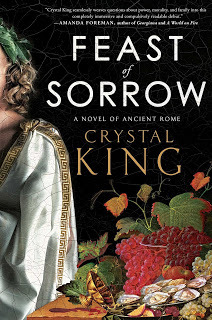 FEAST OF SORROW, long-listed for the Center for Fiction's First Novel Prize, is an imagined retelling of the story of Marcus Gavius Apicius, a wealthy Roman who was a real person that lived in the first century during the time of Caesar August and Tiberius. He was a celebrated gourmand whose name graces the oldest known cookbook. Many of the recipes and techniques in that 2,000+-year-old book still live on today. FEAST OF SORROW is full of food and feasts, love and loss and the glamour and grit of ancient Rome.
FEAST OF SORROW, long-listed for the Center for Fiction's First Novel Prize, is an imagined retelling of the story of Marcus Gavius Apicius, a wealthy Roman who was a real person that lived in the first century during the time of Caesar August and Tiberius. He was a celebrated gourmand whose name graces the oldest known cookbook. Many of the recipes and techniques in that 2,000+-year-old book still live on today. FEAST OF SORROW is full of food and feasts, love and loss and the glamour and grit of ancient Rome. Amazon US Amazon UK
Published on March 26, 2018 23:00
March 25, 2018
Author’s Inspiration ~ Sparked by Scandal by Anna Campbell #Giveaway #Regency #Romance @AnnaCampbelloz
Author’s Inspiration Sparked by Scandal!

Well, now I’ve got your attention, I’d like to thank Mary Anne for inviting me to visit her wonderful blog today. There’s so many fascinating posts here – love the element of myth and folklore in so many of the pieces, too.
One of the fun things about writing Regency Romance is that, very much like our own time, it was an age obsessed with celebrity and scandal. The press was thriving and multifarious, there was an endless hunger for scurrilous stories, and there was also a healthy market for topical cartoons sold as prints. Believe me, if you think some of the stuff that goes on today makes your hair curl, check out the satirical caricatures by people like Cruikshank, Gillray, and Rowlandson.
In this era, the prototypical figure of scandal was Lord Byron – his life still reads like a sensational novel, from his sudden worldwide literary fame, to his love affair with his half-sister and his numerous other affairs across Europe, to his hero’s death at the age of 36, fighting for Greek independence against the Ottoman Empire. When Lady Caroline Lamb called her lover “Mad, bad, and dangerous to know,” she knew what she was talking about.
The tag line for my Dashing Widows series of 6 novellas and now a full-lengther to bring the cycle to a close (at least for the moment – I’m thinking about writing stories for the next generation at some stage) was “Scandal is the new black.” The launching point for Lord Garson’s Bride – in fact the reason for the story being written at all – was a scandal of the kind that Regency audiences just devoured. Doings in high society. Romance and Passion. A heroic return from the dead. A touch of the exotic.
My Dashing Widows novellas feature women who decide they’ve had enough of mourning and that it’s time for them to seek out some fun. But book 6 in the series, Catching Captain Nash, is a variation on the theme because Morwenna, the heroine, isn’t actually a widow at all, even if she doesn’t know it yet. Her husband, the dashing naval captain Robert Nash, was lost at sea and she’s spent five years mourning him. For the sake of her young daughter, and because she knows it’s time to make some sort of life for herself, she agrees to marry all-round upstanding guy Hugh Rutherford, Lord Garson. Not very scandalous so far – but when her long-lost husband returns from the dead to disrupt the ball celebrating Morwenna’s engagement to Garson, the fallout occupies London’s gossips well into the future.
So Morwenna gets her happy ending because she never stopped loving Robert (although it’s not all plain sailing as you’ll discover if you read Catching Captain Nash, currently free on all ebook platforms). But after finishing Captain Nash, I found myself thinking about the runner-up in this particular romantic race, especially as Garson behaved so well when the woman he loved returned to her husband. He plays the least glamorous role in this drama, that of gallant loser, and there’s no way he can lick his wounds in private as Robert’s return to London occurred in the full glare of public attention.
Does the most famous rejected lover in England deserve a love of his own?
Of course he does!
It’s been a real emotional rollercoaster describing Garson’s journey into love with the childhood friend he marries, purely because he thinks she’s his most convenient option. I’ve always enjoyed marriage of convenience stories. There’s such high stakes when the couple are tied together for life – as they are in a historical romance. At the start of the story, neither Jane Norris nor Garson are in love, and both of them fight their inevitable fall tooth and nail. By the end of the story, they’ve both had to recognise that they’re not the people they thought they were, and in the process, they’ve had to face up to some agonising decisions.
There’s always a bittersweet touch to finishing a series because you’re letting go of characters you’ve loved and nurtured through sometimes years of personal growth. But I have to say when I finished writing Lord Garson’s Bride, I felt like the Dashing Widows and their friends had all found such happiness that I could safely leave them to their own devices.
On now to a bunch of Scottish lairds, who definitely need some help in the romance department. You get to meet such interesting people when you’re a writer! Even if they only live in your head!
I’d like you to imagine you live in the Regency. Would you be a good, demure girl with never a word of gossip whispered about you? Or would you be more likely to feature in one of those caricatures of society scandal I mentioned above? If that’s you, what sort of scandal do you think you’d get up to?
I’ve got 2 Kindle downloads of Lord Garson’s Bride to give away here. Just leave me a comment to be in the draw. No geographical restrictions.
Anna Campbell
 Australian Anna Campbell has written 10 multi award-winning historical romances for Grand Central Publishing and Avon HarperCollins and 17 bestselling independently published novellas. Look out for her new series featuring three roguish Scottish lairds beginning in mid-2018.
Australian Anna Campbell has written 10 multi award-winning historical romances for Grand Central Publishing and Avon HarperCollins and 17 bestselling independently published novellas. Look out for her new series featuring three roguish Scottish lairds beginning in mid-2018. Lord Garson's Bride
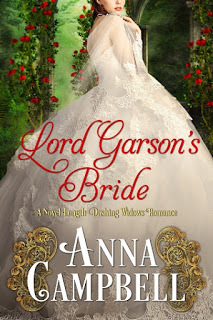 Lord Garson’s dilemma.
Lord Garson’s dilemma.
Hugh Rutherford, Lord Garson, loved and lost when his fiancée returned to the husband she’d believed drowned. In the three years since, Garson has come to loathe his notoriety as London’s most famous rejected suitor. It’s high time to find a bride, a level-headed, well-bred lady who will accept a loveless marriage and cause no trouble. Luckily he has just the candidate in mind.
A marriage of convenience…
When Lady Jane Norris receives an unexpected proposal from her childhood friend Lord Garson, marriage to the handsome baron rescues her from a grim future. At twenty-eight, Jane is on the shelf and under no illusions about her attractions. With her father’s death, she’s lost her home and faces life as an impecunious spinster. While she’s aware Garson will never love again, they have friendship and goodwill to build upon. What can possibly go wrong?
…becomes very inconvenient indeed.
From the first, things don’t go to plan, not least because Garson soon finds himself in thrall to his surprisingly intriguing bride. A union grounded in duty veers toward obsession. And when the Dashing Widows take Jane in hand and transform her into the toast of London, Garson isn’t the only man to notice his wife’s beauty and charm. He’s known Jane all her life, but suddenly she’s a dazzling stranger. This isn’t the uncomplicated, pragmatic match he signed up for. When Jane defies the final taboo and asks for his love, her impossible demand threatens to blast this convenient marriage to oblivion.
Once the dust settles, will Lord Garson still be the man who can only love once?
Amazon UK Amazon US
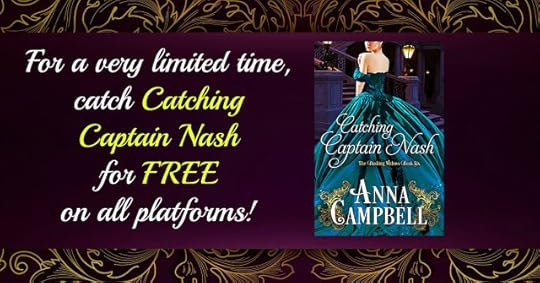
Published on March 25, 2018 23:00
March 23, 2018
Author’s Inspiration ~ Matthew Lewis #history #Medieval #Plantagenet @MattLewisAuthor
It is with the greatest of pleasure that I welcome back historian, Matthew Lewis. Matthew is going to tell us all about his inspiration behind his Amazon bestselling book...
The Survival of the Princes in the Tower:Murder, Mystery and Myth
By Matthew Lewis
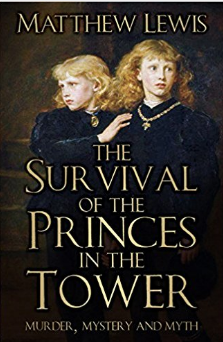
The murder of the Princes in the Tower is the most famous cold case in British history. Traditionally considered victims of a ruthless uncle, there are other suspects too often and too easily discounted. There may be no definitive answer, but by delving into the context of their disappearance and the characters of the suspects Matthew Lewis examines the motives and opportunities afresh as well as asking a crucial but often overlooked question: what if there was no murder? What if Edward V and his brother Richard, Duke of York survived their uncle’s reign and even that of their brother-in-law Henry VII? There are glimpses of their possible survival and compelling evidence to give weight to those glimpses, which is considered alongside the possibility of their deaths to provide a rounded and complete assessment of the most fascinating mystery in history.
Author's Inspiration
The fate of the sons of King Edward IV, remembered as The Princes in the Tower, is one of the most enduring, fascinating and divisive mysteries in all of history. This book seeks to return to the original, contemporary source material, to try and strip away centuries of myth building and confusion. I was intrigued to find out how much of the story we think we know can be substantiated by contemporary evidence.
The book requires an open mind from the reader, not least because, as the title suggests, the real question I wanted to try and answer was whether we could be certain that there was any murder at all in 1483. Most people assume that there was two murders and the only real argument is over who ordered the boy’s deaths. For many, there is little need to look beyond their uncle, King Richard III. Others have identified potential culprits in Henry Stafford, Duke of Buckingham, in Margaret Beaufort, Henry VII’s mother, a theory made popular by Philippa Gregory, or other contemporaries with something to gain.
Each of the candidates accused of the murders has always been problematical to me. The Wars of the Roses has always fascinated me and as a Ricardian, the latter stages hold a particular draw. Add in the mystery of the disappearance of two young princes and I’ve been hooked for years. The traditional story and its variants were never really satisfying. Take Richard III. If he killed his nephews, it was to prevent them from threatening him. In order to bring the threat to an end, everyone had to be made aware that they were dead. To kill them and keep it a secret served no purpose at all. He could have blamed someone else or even claimed they had died of natural causes. It wasn’t really important that everyone believed him, only that everyone knew the princes were dead and could no longer be a threat to him. If Buckingham did it, with or without Richard’s approval, Richard had the perfect opportunity to blame him in October when Buckingham was executed for rebelling. If Margaret Beaufort was behind the deaths, it seems unlikely her son would have been so threatened by pretenders during his reign.
Reading the original material, it very quickly becomes clear that any certainty about the fate of the Princes in the Tower is a much later development. No contemporary could explain definitively what had happened. There were rumours circulating, but they offered different stories of precisely how the boys were killed and by who. Most writers provided more than one potential fate, emphasising the uncertainty that held sway for decades afterwards. The story begins to take a firmer shape with Vergil and More, writing in the following century and both with agendas that impact the reliability of their testimony. After that, writers needed to add another twist or layer of menace to the story to keep it fresh for new readers. Edward Hall exaggerated More’s story went on to become a source for William Shakespeare’s final nail in Richard’s coffin.
What I found was incredibly surprising and made the project well worthwhile. There are snippets during Richard III’s reign that hint at the boys’ continued survival. It is perhaps unsurprising that real, firm evidence from Richard’s reign is lacking. Henry VII had been able to win the throne in no small part because of his promise to marry the princes’ sister Elizabeth. In order to do so, he had to undo the illegitimacy of all of Edward IV’s children which Richard III had enacted in Parliament. We know that Henry had that statute removed from the rolls unread, which in itself is odd. An act repealed by Parliament would usually be read in the House first, but Titulus Regius was not read and Henry ordered all copies returned and destroyed on pain of imprisonment. Given that Henry had, in legitimising his intended wife, he had also legitimised her brothers, their claim to the throne would have become far better, and far more popular, than Henry’s own. Any evidence that they had survived Richard’s reign would have been on Henry’s hitlist every bit as much as Titulus Regius.
I liken the fate of the Princes in the Tower to a black hole. There is no visible evidence of their fate but what we can look for is a gravitational effect on those around them. The two most famous pretenders who threatened Henry VII’s throne then take on a new level of interest. Lambert Simnel has long been believed to have impersonated Edward, Earl of Warwick, but this is far from certain. Why was Elizabeth Woodville stripped of her property and income at the time this threat emerged? Why was the princes’ half-brother Thomas Grey, Marquis of Dorset thrown into the Tower at the same time? What interest would they have in Warwick replacing Elizabeth of York on the throne? Why did Henry VII’s court poet, Prince Arthur’s tutor Bernard Andre write that the boy in Ireland claimed to be a son of Edward IV named Edward? That can only be Edward V. Perkin Warbeck provides similar intriguing questions. How did he speak perfect English if he was a Flemish lad forced to learn English in his late teens? Why did the Holy Roman Emperor Maximilian and the Scottish King James IV never abandon Perkin, even when there was no political gain to continuing to offer him support?
The fate of the Princes in the Tower remains a mystery. The bones currently resting in an urn in Westminster Abbey are unlikely to be theirs, but like everything else about this story, nothing can be proven. Stripping away centuries of myth and received wisdom is an incredibly valuable and revealing exercise. Although this book can’t pretend to provide definitive answers to a mystery that had defied resolution for half a millennium, I think there is plenty for an open-minded reader to think about. Instead of trying to work out who murdered the Princes in the Tower in 1483, perhaps we should give more serious consideration to whether there was a murder at all.
Links for PurchaseAmazon Book Depository
Matthew Lewis
 Matthew Lewis was born and grew up in the West Midlands. Having obtained a law degree, he currently lives in the beautiful Shropshire countryside with his wife and children. History and writing have always been a passion of Matthew's, with particular interest in the Wars of the Roses period. His first novel, Loyalty, was born of the joining of those passions.
Matthew Lewis was born and grew up in the West Midlands. Having obtained a law degree, he currently lives in the beautiful Shropshire countryside with his wife and children. History and writing have always been a passion of Matthew's, with particular interest in the Wars of the Roses period. His first novel, Loyalty, was born of the joining of those passions.Matthew loves to hear from readers, you can find him…
Matt’s History Blog ~ Hopefully interesting snippets and thoughtsFacebook Twitter
Published on March 23, 2018 00:00
March 22, 2018
Celtic Christianity versus Roman Christianity by Christy Nicholas #Ireland #medieval #Christian @greendragon9
Celtic Christianity versus Roman Christianity By Christy Nicholas
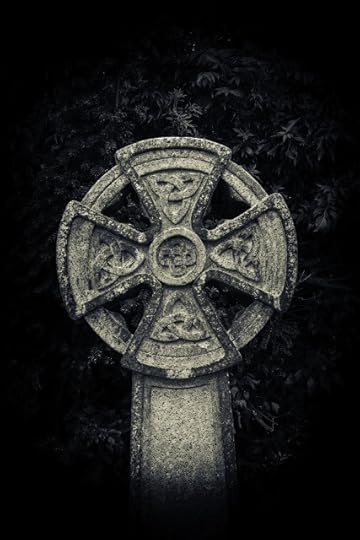
My next novel, Misfortune of Time (due out July 2018), takes place in 1055AD in Ireland. Much of the first portion of the book is set in Clonmacnoise, among the monks and priests that lived and worked in this large, bustling abbey.
During this time, the priests and bishops of Irish and Scottish churches were more likely to follow the dictates and rules of what was known as Ionan Christianity, though we now mostly call it Celtic Christianity. These dictates differed from the commonly accepted practices in Rome and the rest of Western Christendom in several key points. While this was especially true in the 6th and 7thcenturies, before the Synod of Whiby, many traditions were still followed well into the 12th century.
One of the reasons for this dichotomy was who spread the Word. Some of the early teachers of the ideals of monastic life in these areas were Saint Dubric in Wales, Saint Columba in Scotland (who founded the monastery at Iona) and, of course, Saint Patrick in Ireland. They had their own ideas of how to be a Christian monk long before Rome decided on a common way. Saint Patrick had been born in Wales and, presumably, raised on the tradition already in place there. While Christianity had appeared in Ireland before the arrival of Saint Patrick, he is credited with the widespread adoption of the religion. Saint Columba then did a similar spread across the Scottish lands.
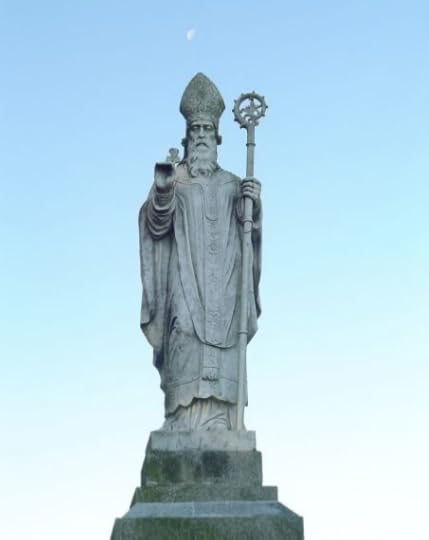 St. Patrick
St. PatrickIn all these lands, but especially in Ireland, monastic communities rose dramatically in the following cemeteries, each following a specific set of rules for their order.
Some of the differences in various regions (not all) include:
· The calculation of the date of Easter· The shape and style of the monastic tonsure (shaving of the head for monks)· The method of private penance to a priest· Monastic isolation or hermitage (peregrination pro Christo)· The ability for priests to marry and have families· Differing views on fasting and corporal punishment (Rule of Columbanus)· Baptism tradition details
 The Roman Tonsure
The Roman TonsureIn addition to the differences between Celtic and Roman Christianity, there were also remnants of the Gaelic Brehon Law at work during this time. Many of these laws still held sway through to the Norman invasion of Ireland in the 12thcentury.
Some of the Brehon Laws included:· Progressive treatment of women, giving greater freedom, independence and rights to property, rights later removed by Canon Law· The right to divorce on many grounds, including impotence or homosexuality· Brehon law allowed and gave rules for polygamy (usually wives)· Relative status of kings versus priests, and the ranks of each· Brehon law did not typically distinguish between legitimate and illegitimate children· Brehon law espoused payment for crimes in wealth (wergild) instead of capital punishment The law in medieval Ireland was an ever-shifting beast, and often what one chief or bishop believed was different from what his neighbor believed. The dying tradition of having a Brehon at each chief’s court, an expert on the law, meant that more and more, the chiefs turned to the church as an expert on such matters, and thus church law came into more and more use as the centuries wore on.
Christy Nicholas
 Christy Nicholas, also known as Green Dragon, is an author, artist and accountant. After she failed to become an airline pilot, she quit her ceaseless pursuit of careers that begin with ‘A’, and decided to concentrate on her writing. Since she has Project Completion Disorder, she is one of the few authors she knows with NO unfinished novels.Christy has her hands in many crafts, including digital art, beaded jewelry, writing, and photography. In real life, she’s a CPA, but having grown up with art all around her (her mother, grandmother and great-grandmother are/were all artists), it sort of infected her, as it were.She wants to expose the incredible beauty in this world, hidden beneath the everyday grime of familiarity and habit, and share it with others. She uses characters out of time and places infused with magic and myth.Combine this love of beauty with a bit of financial sense and you get an art business. She does local art and craft shows, as well as sending her art to various science fiction conventions throughout the country and abroad.
Christy Nicholas, also known as Green Dragon, is an author, artist and accountant. After she failed to become an airline pilot, she quit her ceaseless pursuit of careers that begin with ‘A’, and decided to concentrate on her writing. Since she has Project Completion Disorder, she is one of the few authors she knows with NO unfinished novels.Christy has her hands in many crafts, including digital art, beaded jewelry, writing, and photography. In real life, she’s a CPA, but having grown up with art all around her (her mother, grandmother and great-grandmother are/were all artists), it sort of infected her, as it were.She wants to expose the incredible beauty in this world, hidden beneath the everyday grime of familiarity and habit, and share it with others. She uses characters out of time and places infused with magic and myth.Combine this love of beauty with a bit of financial sense and you get an art business. She does local art and craft shows, as well as sending her art to various science fiction conventions throughout the country and abroad.Christy loves to hear from readers, you can find her: Website Blog Facebook Twitter

Discover author, Christy Nicholas, on Tirgearr Publishing today!!
Published on March 22, 2018 00:00
March 21, 2018
My Arthur Inspiration By Tim Walker #Arthurian #Legend #amwriting @timwalker1666
My Arthur InspirationBy Tim Walker

Okay, I’m being slightly mischievous here – my Author Inspiration has morphed into My Arthur Inspiration. In fact, in setting out to write my Fifth-century historical series, A Light in the Dark Ages, I had more of an Arthur problem than inspiration to address. Here it is: I wanted to write a believable alternative-history of life in Britannia in the immediate years after the Romans abandoned their province, but the Arthurian legend gets in the way.
410 AD is the accepted date for the final separation from Rome, and is therefore a real historical fixing point. What happens next is the subject of conjecture as little evidence survives, apart from a few brief mentions of ‘turbulent times’ by monks Nennius and Gildas who mention high kings Vortigern and Ambrosius Aurelianus by name, but with scant reference to an Arthur (apart from by Welsh chroniclers). This is the problem – the Arthurian legend, as finally laid out in detail by Geoffrey of Monmouth in his History of the Kings of Britain, written around 1136, stands squarely in the way of my planned alt-history. Did Geoffrey have sight of a missing text when writing about Uther Pendragon and King Arthur, or did his imagination run wild? This remains a source of debate with Historians.
Further investigation gives a less murky picture of a possible ‘Arthur’ – a king or ‘leader of battles’ - who came after the two kings mentioned above, whom some historians believe was real enough to have fought and died at the Battle of Camlann around the year 515. So, my Arthur problem is this – assuming Geoffrey’s account is credible, and his lineage of Fifth century kings is valid, then Arthur would have been born around the year 470, and became king at the age of fifteen (as Geoffrey says) in, say, 485. Therefore, he would have been 45 years old when he died in battle. Reasonable enough?
So, now I have my timeline and Geoffrey’s narrative to build my story around:410 Romans leave, Archbishop Guithelin appeals to the Christian King Aldrien of Brittany to come and claim the island as his kingdom.411 Aldrien is too busy and sends his brother, Constantine, with a small force. Constantine is accepted by a council of tribal leaders and becomes king.420 Constantine is murdered on the orders of Vortigern, a sly noble. Vortigern becomes high king and invites Saxons to fight in his army.440 Constantine’s sons, Aurelius and Uther return to Britain with an army. They defeat Vortigern in battle and Aurelius becomes king, taking the name ‘Ambrosius’ (The Divine One). He unifies the tribal chiefs.467 Ambrosius is poisoned and his brother, Uther, succeeds him.Uther’s son, Arthur, is raised in secret by Merlin.485 The teenage Arthur becomes king following Uther’s death.
Over three books I’ve attempted to tell this story (or ‘sell’ this story), with some embellishments, as an account of a lost period in our history – The (early) Dark Ages. What really happened? Will we ever find out? Until we do, it remains in the realm of myths and legend.

Whether I have succeeded in de-mystifying Uther Pendragon and King Arthur by presenting them as ‘real’ historical figures in the context of a constructed alt-history, is for my readers to judge. If it wasn’t them, then it was other, similar, leaders - it is a safe assumption that the Britons did organise themselves in defence of their island against the slow colonisation of Angles, Saxons and Jutes over the ensuing three hundred years.
This is my contribution to the Arthurian legend debate – to give credence to Geoffrey of Monmouth’s account and attempt to present his kings as believable historical characters.
Tim Walker
 Tim Walker is an independent author based in Windsor, UK. Tim’s background is in marketing, journalism, editing and publications management. He began writing an historical series, A Light in the Dark Ages (set in the Fifth Century), in 2015, starting with a novella set at the time the Romans left Britain – Abandoned. This was followed in 2017 with a novel – Ambrosius: Last of the Romans, and the third installment, Uther’s Destiny, has just been released in March 2018.
Tim Walker is an independent author based in Windsor, UK. Tim’s background is in marketing, journalism, editing and publications management. He began writing an historical series, A Light in the Dark Ages (set in the Fifth Century), in 2015, starting with a novella set at the time the Romans left Britain – Abandoned. This was followed in 2017 with a novel – Ambrosius: Last of the Romans, and the third installment, Uther’s Destiny, has just been released in March 2018.His creative writing journey began in July 2015 with the publication of a book of short stories, Thames Valley Tales. In 2016 his first novel, a futuristic/dystopian thriller, Devil Gate Dawn was exposed on the Amazon Scout programme prior to publication. Both titles were re-launched with revised content, new covers and in print-on-demand paperback format in December 2016.
In January 2017 his first children’s book, The Adventures of Charly Holmes, co-written with his 12-year-old daughter, Cathy, was published. In September 2017 he published a second collection of short stories – Postcards from London.
Tim loves to hear from readers, you can find him: Website NewsletterAmazon Author Page Facebook Twitter
Uther’s Destiny
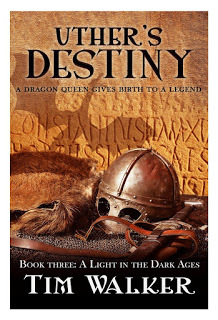 In the year 467 AD Britannia is in shock at the murder of charismatic High King, Ambrosius Aurelianus, and looks to his brother and successor, Uther, to continue his work in leading the resistance to barbarian invaders. Uther’s destiny as a warrior king seems set until his world is turned on its head when his burning desire to possess the beautiful Ygerne leads to conflict. Could the fate of his kingdom hang in the balance as a consequence?
In the year 467 AD Britannia is in shock at the murder of charismatic High King, Ambrosius Aurelianus, and looks to his brother and successor, Uther, to continue his work in leading the resistance to barbarian invaders. Uther’s destiny as a warrior king seems set until his world is turned on its head when his burning desire to possess the beautiful Ygerne leads to conflict. Could the fate of his kingdom hang in the balance as a consequence?Court healer and schemer, Merlyn, sees an opportunity in Uther’s lustful obsession to fulfil the prophetic visions that guide him. He is encouraged on his mission by druids who align their desire for a return to ancient ways with his urge to protect the one destined to save the Britons from invaders and lead them to a time of peace and prosperity. Merlyn must use his wisdom and guile to thwart the machinations of an enemy intent on foiling his plans.
Meanwhile, Saxon chiefs Octa and Ælla have their own plans for seizing the island of Britannia and forging a new colony of Germanic tribes. Can Uther rise above his family problems and raise an army to oppose them?
Book three in A Light in the Dark Ages series, Uther’s Destiny is an historical fiction novel set in the Fifth Century - a time of myths and legends that builds to the greatest legend of all – King Arthur and his knights.
Amazon
Published on March 21, 2018 00:00
The Coffee Pot Book Club
The Coffee Pot Book Club (formally Myths, Legends, Books, and Coffee Pots) was founded in 2015. Our goal was to create a platform that would help Historical Fiction, Historical Romance and Historical
The Coffee Pot Book Club (formally Myths, Legends, Books, and Coffee Pots) was founded in 2015. Our goal was to create a platform that would help Historical Fiction, Historical Romance and Historical Fantasy authors promote their books and find that sometimes elusive audience. The Coffee Pot Book Club soon became the place for readers to meet new authors (both traditionally published and independently) and discover their fabulous books.
...more
...more
- Mary Anne Yarde's profile
- 159 followers



